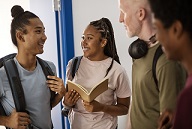Teaching Spanish to migrants in Spain: the teacher´s perspective
Keywords:
Abstract
The aim of this paper is to approach the reality of Spanish classrooms for migrants in Spain and to reflect on different aspects of this type of teaching from the teachers' perspective. For this purpose, we have worked with a sample of 20 teachers of Spanish for migrants in several organizations located in different Spanish cities, who were interviewed between 2021 and 2022. The study is descriptive in nature with a qualitative data analysis and focuses on three dimensions: the students, the teachers and the teaching process. The results show that, in relation to migrant students, teachers consider their students to be vulnerable, but also indicate that they are more motivated by the need to know the language in order to find work and integrate into the host society. They also agree that a teacher with migrant students should be empathetic, patient, understanding, capable of mediating possible conflicts and interested in the social work involved in this type of work. As for the teaching process, the need to adapt materials and focus on a communicative approach that enables students to use the language in their daily lives was emphasized. The lack of autonomy of the students and the need to improve written comprehension and expression were highlighted as weaknesses. It should also be noted that this study is based on the teachers' experience, so it would be advisable to expand it with future research that gathers new data, such as the students' experience or the evolution of teaching in recent years.
Downloads
Altmetrics
References
Arroyo González, M. J., and Rodríguez Correa, M. (2014). Enseñanza de segundas lenguas a alumnado inmigrante: evaluación de las estrategias y aprendizajes conseguidos. Tendencias pedagógicas, (24), 327-346. http://hdl.handle.net/11162/119847
Benallou, S. (2023). Motivación del alumnado en el aula de ELE. Hispanical, 2(1), 91-97. https:// www.asjp.cerist.dz/index.php/en/article/210543
Bustamante, N., y Díaz, S. (07-07-2023). Cambios en las características de la población inmigrante en España en los últimos años. Caixabank Research. https://www.caixabankresearch.com/es/economia-y-mercados/mercado-laboral-y-demografia/cambios-caracteristicas-poblacion-inmigrante
Ceballos Vacas, E., y Trujillo-González, E. (2021). Dificultades y apoyos emocionales del alumnado migrante: un estudio de caso en un instituto multicultural. Aula Abierta, 50(4), 767–776. https://doi.org/10.17811/rifie.50.4.2021.767-776
Crozet, C. (2016) The intercultural foreign language teacher: challenges and choices. En M. Dasli y A. Diaz (Eds), The critical turn in language and intercultural pedagogy: theory, research & practice (pp. 143-161). Routledge: Series Studies in Language and Intercultural Communication.
Diambang, O., and Diop, P. M. (2023). Escritura en ELE en el contexto escolar de Senegal: análisis de las creencias de alumnos de nivel inicial. MarcoELE: Revista de Didáctica Español Lengua Extranjera, (36), 1-20. https://marcoele.com/creencias-escritura-en-senegal/
Domingues Cruz, M., y Saracho Árnaiz, M. (2020). Del enfoque comunicativo experiencial a la gamificación en la clase de ELE: aplicaciones prácticas del modelo Octalysis. In Perfiles, factores y contextos en la enseñanza y el aprendizaje de ELE/EL2 (pp. 259-272). Universidad de Santiago de Compostela. https://cvc.cervantes.es/ensenanza/biblioteca_ele/asele/pdf/29/29_0017.pdf
García Cano, P. M. (2022). Metodología de atención a inmigrantes y refugiados políticos en instituciones de enseñanza no reglada de EL/2. Recursos para el aula de español: investigación y enseñanza, 1(2), 30-72. https://doi.org/10.37536/rr.1.2.2022.1844
Government of Spain. Ministry of Education, Vocational Training and Sports (n.d.). Estudiar español en España. https://www.educacionyfp.gob.es/mc/redele/estudiar-espa-ol-como-lengua-extranjera-en-espa-a.html
Gómez-Pavón Durán, A. (2019). Análisis de necesidades y planificación del curso en un grupo de estudiantes migrantes adultos de ELE. Foro de Profesores de E/LE, (15), 127-136. https:// doi.org/10.7203/
González Fernández A. (2023). Análisis del tratamiento de las formas canto y cante en un corpus de manuales de ELE: terminología, valores, ejemplos, actividades e imágenes. Círculo de Lingüística Aplicada a la Comunicación, 95, 49-65. https://doi.org/10.5209/clac.90077
González-Monteagudo, J., and Zamora-Serrato, M. (2019). Los profesores y los desafíos de las diversidades y de las migraciones en España: formación y políticas educativas. Revista de Educação Pública, 28(68), 275-296. https://doi.org/10.29286/rep.v28i68.8389
Horno-Cheliz, M. C., and Vicente-Molinero, C. (2020). A competência sociolinguística como um mecanismo de integração de migrantes. Um estudo sobre as expectativas pragmáticas do espanhol em três situações comunicativas básicas: trabalho, saúde e educação. Revista EntreLinguas, 6(1), 71–85. https://doi.org/10.29051/el.v6i1.13267
INE (2022). Estadística de migraciones. Instituto Nacional de Estadística. https://www.ine.es/
Jiménez Jiménez, A., and Níkleva, D. G. (2015). Textos sonoros 2.0 para la enseñanza del español a alumnado inmigrante. In F. J. García Castaño, A. Megías Megías y J. Ortega Torres (eds.), Actas del VIII Congreso sobre Migraciones Internacionales en España (pp. 227–239). Instituto de Migraciones. http://hdl.handle.net/ 10481/41833
Kárpava, A. (2022). Competencia comunicativa noviolenta. Propuesta didáctica de enseñanza de español a los inmigrantes para los educadores sociales. RES: Revista de Educación Social, (34), 246-263. https://eduso.net/res/revista/34
Kramsch, C. (2014). Teaching foreign languages in an era of globalization: Introduction. The Modern Language Journal, 98(1), 296–311. https://doi.org/10.1111/j.1540- 4781.2014.12057.x
Legaz-Torregrosa, H., y Toscano Fuentes, C. (2022). Necesidades formativas del profesorado para la enseñanza de ELE en adultos migrantes. Revista Nebrija de lingüística aplicada a la enseñanza de lenguas, 16(33), 53–64. https://revistas.nebrija.com/revista-linguistica/article/view/491
Ley Orgánica 4/2000, de 11 de enero, sobre derechos y libertades de los extranjeros en España y su integración social. Boletín Oficial del Estado, 10, de 12 de enero de 2000. https://www.boe.es/buscar/doc.php?id=BOE-A-2000-544#:~:text
McAuliffe, M., and Triandafyllidou, A. (eds.) (2021). Informe sobre las Migraciones en el Mundo 2022. Organización Internacional para las Migraciones (OIM), 1-564. https://publications.iom.int/books/informe-sobre-las-migraciones-en-el-mundo-2022
Martin, A. J., Burns, E. C., Collie, R. J., Cutmore, M., MacLeod, S. and Donlevy, V. (2022). The role of engagement in immigrant students’ academic resilience. Learning and Instruction, 82, https://doi.org/10.1016/j.learninstruc.2022.101650
Moles-López, E., Burgos-Jiménez, R. J., and Añaños, F. T. (2023). Migración e integración en España: Factores que influyen en la percepción de la inmigración. In R. Vieira, M.V. Pérez de Guzmán, J.C. Marques, P. Silva, A.M. Vieira, C. Margarido, R. Matos, R. Santos (orgs.), Pedagogia social e Mediação Intercultural: Teoria e Prática na Intervenção Socioeducativa. Livro de Atas del XXXIV Congreso Internacional da SIPS e 10.ª Conferência Internacional de Mediação Intercultural e Intervenção Social, (pp. 38-49), CICS.NOVA.IPLeiria e ESECS.Politécnico de Leiria. http://doi.org/10.25766/d6g0-b749
Morales Rodríguez, E. M. (2021). Lo que hemos aprendido durante la pandemia: Estudio de la experiencia del profesorado de EL2 a inmigrantes durante la pandemia de Covid-19. In M.
I. Asensio Pastor (coord.), Aprendizaje de español como segunda lengua en entornos educativos multilingües, (pp. 80-103), Editorial Universidad de Almería.
Níkleva, D. G., and García-Viñolo, M. (2023). La formación del profesorado de español para inmigrantes en todos los contextos educativos. Onomázein, (60), 167–188. https://doi.org/10.7764/onomazein.60.10
Primo Doncel, S. (2020). La interculturalidad y la competencia sociocultural en el aula de EL2 para inmigrantes. E-eleando: Ele en Red. Serie de monografías y materiales para la enseñanza de ELE, (18), 1-100. http://hdl.handle.net/10017/44036
Soliman, M. (2022). La multimodalidad en el material didáctico de ELE: una perspectiva práctica. REXE- Revista De Estudios Y Experiencias En Educación, 21(46), 190–207. https://doi.org/ 10.21703/0718-5162.v21.n46.2022.010
Sosinski, M. (2018). Perfil de profesores de E2L de inmigrantes adultos (no alfabetizados). Doblele: revista de lengua y literatura, 4, 61-81. DOI: 10.5565/rev/doblele.41
Sun, S., and Herrero-Fernández, C. (2022). Rasgos melódicos de la expresión de la alegría en el español L2 hablado por inmigrantes sinohablantes residentes en Madrid (España). Revista da Abralin, 21(2), 150–173. Doi: 10.25189/rabralin.v21i2.2076
Valenti, N. E. (2006). ¿Visión intercultural, multicultural, etnocéntrica? Algunas reflexiones sobre la formación del mediador en el aula de ELE. In A. Cancellier, M. C. Ruta y L. Silvestri (coord.), Scrittura e conflitto. Actas del XXI Congreso AISPI (Catania-Ragusa, 16-18 de mayo de 2004) (pp. 319–334). Instituto Cervantes. https://cvc.cervantes.es/literatura/aispi/pdf/20/ii_21.pdf

By submitting a proposal, the author agrees to the following terms:
- a) The author retains the authorship rights, granting the journal the right of first publication of the work.
- b) The texts will be disseminated with the Creative attribution license Commons 4.0. BY that allows you to share, copy and redistribute the material in any medium or format, as well as adapt, remix, transform and build on the material for any purpose, including commercially.







